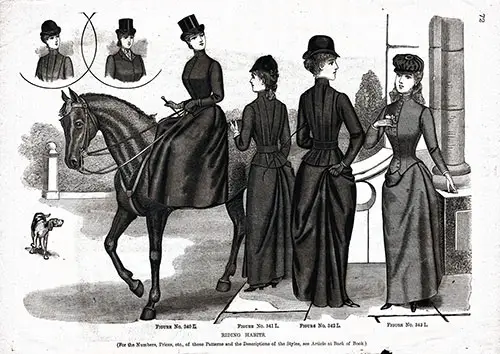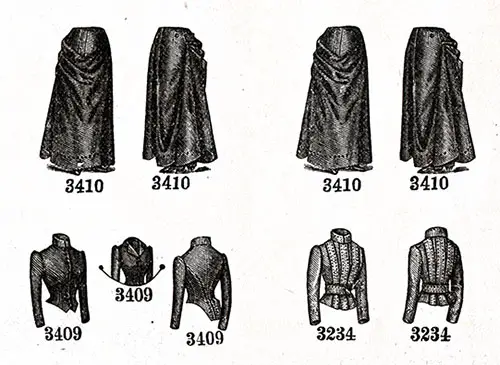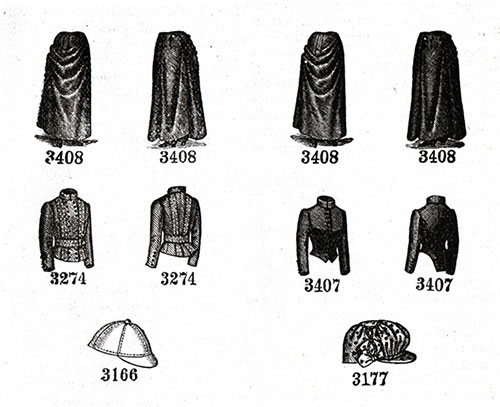Ladies and Teens Riding Garments - 1890

Riding Habits (left to right): Figure No. 340 L (on horse); Figure No. 341 L; Figure No. 342 L; and Figure No. 343 L.
There can be little doubt that equestrianism is one of the most healthful and enjoyable of the many forms of outdoor exercise.
Although until a comparatively recent date its benefits and pleasures have practically been restricted, particularly among females, to those who dwell in the country, the ability to ride well and gracefully is now considered one of the leading accomplishments of the city-bred woman, as is evidenced by the increasing number of good riders to be seen in the parks and on the pleasant suburban highways.
Much patient practice, courage and presence of mind are essential to make a successful horsewoman, and the learner must not heed the natural weariness resulting from her first lessons, if she would attain the much-desired proficiency.
Women are prone to vault in the saddle, regardless of the motion of the horse. To rise uniformly with the horse, to apparently become a part of him, and to keep the heel of the stirrup foot and the toe of the other well down are the secrets of good riding, and it is well to bear in mind and carefully heed the maxim, “The heels and hands down, the head and heart high.”
The cut-back tree saddle is the newest and most favored style. It has a level seat covered with hog-skin, in which the rider may sit evenly and squarely, the result being a natural and graceful position; whereas in the straight-head tree saddle, the seat of which is hollowed, the knee is. bent, and the position is more cramped in consequence.
The most approved saddle has two pommels, the third pommel being seen only on the reversible saddle, which is to be preferred for the young, because, if a growing child always rides in the same position, the person becomes unequally developed or one-sided.
Tasteful and fashionable riders just now choose unmounted saddles of oak-colored leather, with all the other trappings to correspond. Bridles having the short check-curb bit are in most general use, and they have been proven the most effective and practical style for general riding.
ln a sense, a bond of sympathy should be established between horse and rider, the quicker intelligence of the latter comprehending every action and mood of the former; for if this understanding or, rather, fellowship exist between a well broken horse and his mistress, there will be small need of either whip or spur.
Fashion, however, demands that a whip be carried, if only for ornament. Fastidious riders carry a short, stiff cane of blackthorn, ash or cherry with a metal top; but while these canes are intended to do service as whips, they are in reality useless.
The crop is considered the more graceful, because of the loop end, with which the rider merely flecks the horse; for more than this is not necessary when horse and rider are as good friends as they should be.
The improved crop combines both whip and spur, the latter being no longer appended to the boot, but set in the handle of the crop, so that by a slight pressure the steel point may be made to do its cruel work.
The whip is liked for park riding, but the crop is invariably used for hunting, because a lash may be conveniently attached to the loop end. Buckhorn and engraved or plain silver handles are the prevailing styles for whips and crops.
Select all the equipment with discretion, giving especial attention to the saddle, for if this is ill-fitting, it will produce unhappy insults for both rider and horse.
The Equestrienne Fashion
The next item to be considered (and it is one upon which the fair equestrienne lays great stress) is proper attire, and progressive Fashion has decreed that the stylish feminine rider shall no longer be encumbered with long, flowing skirts that interfere so materially with her comfort and ease of motion.
Simplicity of design and finish and a faultless fit are the requisites of a fashionable habit, and these attributes characterize all the riding garments which are illustrated in this magazine and described below.
The dark-colored habit has been so long in favor that the use of a light-hued fabric for the purpose seems to be a too decided departure from a time-honored custom.
However, la Mode has sanctioned such a change and has introduced habits of light color, white flannel, white linen duck and unbleached or écru drilling being approved for them.
Though undeniably conspicuous, habits made of these materials are wonderfully cool and trim-looking. Stockinet is also used for riding habits. It is shown in mixed brown, black, blue and gray, and its elasticity is its strongest recommendation.
This material is used for the entire habit, and its texture causes it to yield gracefully to every motion of the wearer.
The stylish effect of dark-blue stockinet is illustrated in the habit represented at figure No. 340 L. The skirt and trousers are included in the same pattern.
The trousers are shaped by the customary center and leg seams and are fitted smoothly at the top by darts.
The right leg is cut longer than the left, this being necessary to secure a comfortable adjustment of the garment when the wearer is in the saddle; and a strap is added only when shoes are worn.
Trunk-hose of silk or Lisle webbing, commonly called riding-tights, are worn under the trousers, which are slipped beneath the tops of the boots when these are preferred to shoes.
The skirt, which in this instance is short (the pattern providing for two lengths), is smoothly adjusted across the hips by means of darts that are regulated in depth, other darts being introduced at the right side to properly dispose of the fulness when the rider is in the saddle.
The right side of the skirt is longer than the left, the length being taken up when the wearer is riding, so that, as in this instance, the lower outline appears uniform.
Buttons are sewed to the top of the skirt to secure it to the basque; and underneath the front-breadth is attached an elastic band, to the loose end of which is sewed a loop, into which the foot is passed to hold the skirt in position.
The basque is shaped by all the darts and seams necessary to a close and smooth adjustment, and the closing edges are curved, a notch being formed below the closing. The sides are short and arching, and the back is in the approved habit style.
The collar stands high, and the coat sleeves fit with great precision. A short riding-corset is worn in preference to the ordinary corset; and for cool days, when a jacket is not desired, a Spencer of silk or Lisle webbing is worn under the basque.
The gloves are mousquetaires of brown doeskin. Tilburyed gloves with large brass buttons are good form for riding as well as for driving, and leather cuffs of corresponding color are provided to be attached to the gloves in gauntlet fashion, if preferred to the smooth wrists.
The hat is a beaver, bound and banded with hatter’s galloon, and if a veil is desired, a round one of plain black illusion should be chosen.
For Summer wear a chemisette and tie of linen or piqué are frequently adopted, in which event the basque is reversed at the neck and a rolling collar added, the pattern providing for these modifications, which are illustrated in the small figure to the left of the one just described.

The patterns employed in fashioning this stylish habit were skirt and trousers No. 3410, which costs 1s. 6d. or 35 cents; and basque No. 3409, price 1s. 3d. or 30 cents.
The effect of the lengthened side of a riding skirt regulated to a depth convenient for walking is shown at figure No. 342 L. The material selected for this habit is dark-green satin-cloth, which is similar to broadcloth.
The right side of the skirt, being the longer, is lifted by a loop of braid passed over a button sewed near the top. In this instance a back view of the habit is illustrated.
The skirt and trousers were fashioned by pattern No. 3410, which costs Is. 6d. or 35 cents, and is described at figure No. 340 L.
The basque has the appearance of a Norfolk jacket, but is shaped to fit snugly. Three box-plaits are applied to the front, and the same number are correspondingly laid on the back, each plait being sewed to position with machine-stitching.
A white linen collar is worn inside the standing collar, which has a line of stitching at the top. Three rows of stitching are made at cuff depth on each of the coat sleeves, and white linen cuffs are worn.
The dark-brown gloves have Tilburyed palms, and the hat is a jaunty black felt Derby. A partial front view of the basque is shown at the first of the small figures in the upper left corner.
The pattern of the basque is No. 3234, which costs 1s. 3d. or 30 cents. Mixed meltons and dark-colored corkscrews are very popular materials, but black is not as popular as formerly.
The miss is schooled to ride with as much grace and elegance as her elder sister, and a like degree of simplicity distinguishes her costumes, similar materials being employed in their development.
At figure No. 341 L is given a back view of a habit made of brown serge of heavier quality than the ordinary dress serge.
The trousers, which, as in the ladies’ habit, are included in the pattern with the skirt, are provided with all the necessary shaping seams and darts, and the right leg is lengthened to affect a comfortable disposal in the saddle.
A strap is arranged at the bottom of each leg and passed under the foot to adjust the trousers securely about the ankle.
The skirt is fitted smoothly at the top by a clever arrangement of darts, and the extra length allowed at the right side is disposed of when the wearer is walking by loops of tape adjusted over buttons, a becoming graceful drapery effect being the result.
When the rider has dismounted the foot is disengaged from the loop attached to the end of an elastic strap that is arranged underneath the front at the right side.
Buttons are sewed to the top of the skirt for attaching it to the basque, all possibility of disarrangement being thus avoided.
The basque has the customary shaping seams and is closed in double-breasted fashion. A box-plait is applied to the front at each side of the closing and to the back at each side of the center, the latter plaits flaring both above and below the waist-line; and a belt encircles the waist.
The coat sleeves are perfectly close of fit, and the standing collar is moderately high. The cap is of velvet and suggests the jockey shape; the sections of which it is composed meet in a point at the top under a button, a visor is added in front, and a ribbon bow is placed at the center of the back at the lower edge.
The hair is worn in a youthful and pretty fashion, a braid being looped up with ribbon at the nape of the neck. The gloves are of tan kid in mousquetaire style.

The skirt and trousers were cut by pattern No. 3408, price 1s. 3d. or 30 cents; the basque by pattern No. 3274, price Is. or 25 cents; and the cap by pattern No. 3166, price 5d. or 10 cents.
At figure No. 343 L is portrayed a misses’ habit made of gray diagonal. The skirt was cut by pattern No. 3408, which costs 1s. 3d. or 30 cents, and is again illustrated at figure No. 341L. It hangs with all the grace and convenience of a walking skirt.
The basque is fitted in the regulation manner and curves high over the hips, and the fronts shape a deep notch below the closing, while the back falls in habit fashion over the skirt. The high standing collar is close-fitting, and the coat sleeves fit easily. A linen collar and cuffs are worn.
The pattern used for shaping this basque was No. 3407, price 1s. or 25 cents. The cap is a becoming and youthful style. The crown is gathered to a circular center-piece, and a visor is joined to the lower edge of the crown in front.
The cap pattern is No. 3177, price 5d. or 10 cents. The gloves are of heavy tan kid. Derby and low beaver hats are frequently worn by misses.
All the delights and benefits of riding may be counteracted and destroyed by the after results unless the rider takes proper precautions to preserve her health.
The underclothing, which naturally becomes damp from the heat of the body, should be changed at once for dry clothing, if possible; and if this cannot be conveniently done, the rider must on no account expose herself to draughts, but should reduce the heat of the body gradually.
A sudden chill after physical exercise of any sort is frequently followed by very serious and sometimes fatal results.
"Ladies’ and Misses’ Riding Garments," in The Delineator: A Journal of Fashion, Culture, and Fine Arts – Midsummer Number, New York: Butterick Publishing Co., Ltd, Vol. XXXVI, No. 2, August 1890, P. 122-123 (For Illustrations see Page 72, 122-123).
Editor's Note: Some terminology used in the description of women's clothing during the 1800s and early 1900s has been changed to reflect more modern terms. For example, a women's "Toilette" -- a form of costume or outfit has an entirely different common meaning in the 21st century. Typical terms applied to "toilette" include outfit, ensemble, or costume, depending on context.
